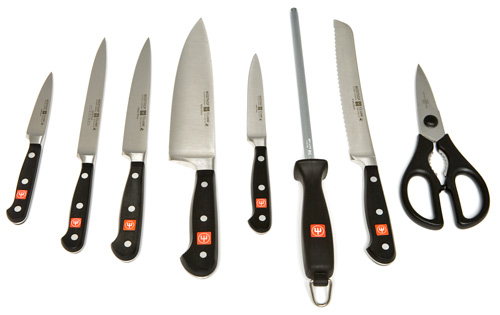Get our independent lab tests, expert reviews and honest advice.
How to buy the best kitchen knife

How well a kitchen knife cuts is very important, but it also needs to feel good in your hand.
On this page:
- Cook's vs chef's knife
- The different types of knives
- Stamped vs forged
- Are expensive knives worth it?
- What to look for in a kitchen knife
- How to care for your kitchen knives
- The different parts of a knife
Your main kitchen knife will be a chef’s knife or a cook’s knife. It should have a comfortable, decent-sized non-slip grip handle; good balance; and a nice curve on the blade.
Maggie Beer, author of Maggie’s Harvest and star of the ABC TV show The Cook and the Chef, says feel and balance are what she looks for in a knife.
“It has to feel good as soon as you put it in your hand. If a knife feels right you can get to the stage where it truly becomes an extension of your arm rather than just a kitchen tool,” says Beer.
In this guide we explain the different types of knives, how to choose the right knife for you, and whether it’s worth paying top dollar.
Cook’s vs chef’s knife
The standard, ‘all-purpose’ kitchen knife is typically categorised as either a cook’s or chef’s model.
The implication is that cook’s knives are the more affordable option designed for all consumers, whereas chef’s knives are for serious enthusiasts with the quality to match. We test both types in our kitchen knives review.
A quick online search suggests that chef’s knives have (among other things) higher quality materials, contoured handles, larger bolsters and curved blades to improve slicing precision. However, all of the cook’s and chef’s models in our test had curved blades and a variety of handle types and bolster sizes.
Chef’s knives outperformed most (but not all) of the cook’s knives in our test
We also found some chef’s knives that were cheaper than cook’s knives. For example, the $8 Anko knife from Target or K-Mart is classified as a chef’s knife, yet Global and Wüsthof sell cook’s knives with an RRP of $199 each.
All that said, chef’s knives outperformed most (but not all) of the cook’s knives in our test. So, while the marketing is a bit murky, there is an argument to be made for the quality of chef’s knives in most cases.
The different types of knives
While cook’s and chef’s knives are multipurpose, other knives are designed for specific jobs – such as paring, carving or filleting.
If you want knives for these purposes, it may be worth investing in a knife set, as this may be cheaper and more convenient than buying knives separately.
Here are some of the more common knife types and accessories that you might find in a set:

Paring knife: This little knife is handy for peeling and trimming fruit, potatoes and other vegetables.
Filleting knife: Good for removing skin from fish, butterflying meats and precise work with raw meat, fish or chicken.
Carving knife: Usually has a longer blade but isn’t as deep as a chef’s knife. The longer blade is good for slicing wider joints, such as cooked ham.
Chef’s or cook’s knife: A very versatile knife that can handle a wide variety of foods and textures.
Utility or all-purpose knife: Similar to the paring knife but with a longer blade; it’s good for small, everyday cutting jobs.
Bread knife: The serrated edge of this knife helps cut through a loaf of bread without squashing it.
Honing steel: To keep a good, fine cutting edge on your knives.
Shears: Kitchen shears are good for cutting chicken around the bones, but they can also be used for cutting herbs or snipping bacon into pieces, and even opening packaging. They generally pull apart for easy cleaning.
Stamped vs forged
There are two ways knives are made.
Stamped knives
Blades are machine-stamped from a piece of steel and then ground, polished and honed. Stamped knives are often lighter than forged knives, which can suit some people better.

Forged knives
Blades are made from a single piece of steel that’s been heated, moulded, hardened, tempered and then ground into a cutting edge. They often have a better feel and balance, and the heavier blade is good for cutting tougher foods.
Forged knives are often more expensive than stamped and also often said to be better, but our tests found this isn’t necessarily so. Base your decision on how the knife feels for you.
Are expensive knives worth it?
Kitchen knives with a recommended retail price (RRP) of $100 or more mostly outperformed cheaper options in our most recent kitchen knife review. So it’s worth spending that little bit extra if you’re able to, but this comes with two caveats:
- Performance often varies across models that cost over $100. A $400 model, for example, isn’t necessarily better than a $200 one.
- There are plenty of cheaper models that provide a good quality cut, which may make them a better value buy for you.
Also, kitchen knives are almost always on sale. Retail prices are typically well below the RRP, even outside usual sales periods such as EOFY and Black Friday.
If you find a kitchen knife that you like that isn’t on sale, shop around or wait a few weeks, as it’s likely to drop below the asking price by a pretty decent margin.
What to look for in a kitchen knife
Balance
A well-balanced knife with a good curve on the blade allows it to roll all the way to the tip when cutting.
Comfort
This comes down to preference and whether you’re right- or left-handed, so try the knives before buying.
Handle
Available in a variety of materials, handles are either flat or curved in shape, with the latter designed to fit the contour of your hand. Materials and shape are a matter of personal preference.
Bolster
This is the point between the handle and the blade, and it’s designed to add weight and balance between these parts of the knife. Some knives use a thick piece of metal, which can give your index finger a place to rest and provide protection if your hand slides forward off the handle.
Safety
A knife that easily sits on its back exposing the blade isn’t the safest option.
Rockwell Hardness rating
The Rockwell Hardness rating is a unit of measurement used for calculating a material’s hardness. In our latest test, some of the manufacturers stated the Rockwell rating, which ranged from 55 to 58.
A higher rating helps retain edge sharpness for a longer period of time, but this also leaves the knife prone to damage as it increases the brittleness. A lower rated knife may last longer, but will need to be sharpened more often.

How to care for your kitchen knives
Once you’ve got a knife that works for you it’s important to take good care of it.
Chopping surface
Always use a chopping board that’s softer than the knife, such as wood or plastic, to help avoid blunting or getting nicks in the blade.
Sharpening
Knives need to be sharpened from time to time to keep their cutting edge fine. While stone sharpening is the best method, you can also use honing steels or pull-through sharpeners. But eventually the knives will need to be professionally sharpened. Most good cookware shops offer this service.
Cleaning
Don’t leave food to dry on the blade, as some foods contain acid that can permanently stain it.
Some manufacturers claim their products are ‘dishwasher-safe’, but they still recommend washing your knives by hand. And some dishwasher detergents are simply too harsh, so if you want to be on the safe side, washing by hand is the way to go.
Storing
Keep your knives clean and store them in a knife block, or use a guard to protect the blade from being knocked and chipped if they’re in a drawer.
The different parts of a knife
Knives may look like nothing more than a blade and handle, but there are actually quite a few components involved. The diagram below is a chef’s or cook’s knife.

Point: The end of the knife where the edge and spine come together.
Tip: The front third of the blade working backwards from the point, used for smaller slices.
Blade: The body of the knife which varies in shape and size depending on the type and method of manufacturing.
Spine: The top of the knife that runs parallel to the edge. This is flat and can be used to rest your hand for harder or finer slicing and chopping.
Edge (aka belly): The main part of the knife used for the majority of slicing.
Heel: The back of the blade adjacent to the handle. This is the strongest part of the knife and the proximity to your hand makes it ideal for tough cutting.
Bolster: The point between the handle and the blade, designed to add weight and balance between these parts of the knife. Some knives use a thick piece of metal which can give your index finger a place to sit and provide protection if your hand slides forward off the handle.
Tang: The metal connected to the blade encased in the handle. Look for knives with a full tang that runs all the way through the handle as it helps strengthen and balance the knife.
Handle: The part that you grip when cutting. Available in a variety of materials and either flat or curved shape, with the latter designed to fit the contour of your hand. Materials and shape are a matter of personal preference. The handle is either moulded to the tang or attached with rivets.
Butt: The back end of the handle.






